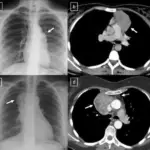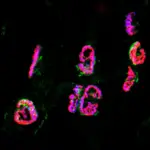Lambert-Eaton myasthenic syndrome is an autoimmune disease of the neuromuscular junction caused by antibodies that block the presynaptic release of acetylcholine.
What is the Pathology of Lambert-Eaton Myasthenic Syndrome?
The pathology of Lambert-Eaton myasthenic syndrome is:
-Etiology: The cause of lambert-eaton myasthenic syndrome is the presence of small cell lung cancer, autoimmune diseases,
-Genes involved: NA.
-Pathogenesis: The sequence of events that lead to lambert-eaton myasthenic syndrome antibodies attack the voltage-gated calcium channels causing insufficient depolarization which leads to a low release of acetylcholine.
-Morphology: NA.
-Histology: NA.
How does Lambert-Eaton Myasthenic Syndrome Present?
Patients with Lambert-Eaton myasthenic syndrome typically are both male and present at the age range of 30- 60 years. The symptoms, features, and clinical findings associated with lambert-eaton myasthenic syndrome include proximal muscle weakness, depressed tendon reflexes, post-tetanic potentiation, and autonomic changes.
How is Lambert-Eaton Myasthenic Syndrome Diagnosed?
Lambert-Eaton myasthenic syndrome is diagnosed by electromyography, physical examination, complete blood count, repetitive nerve stimulation.
How is Lambert-Eaton Myasthenic Syndrome Treated?
Lambert-Eaton myasthenic syndrome is treated by treating the underlying malignancy, avoiding drugs that increase muscle weakness.
What is the Prognosis of Lambert-Eaton Myasthenic Syndrome?
The prognosis of the lambert-eaton myasthenic syndrome is hard to determine since the type of cancer one presents with is the main key.



